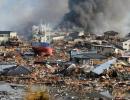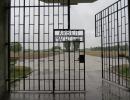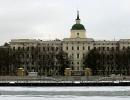Why does Beijing suffer from dense smog? Air pollution levels in Beijing have become life-threatening Real air pollution in Beijing
The average daily concentration of fine particulate matter PM 2.5, which is the main source of smog, exceeded 350 micrograms per cubic meter in some areas on Saturday, the Beijing Conservation Monitoring Center reports. environment. This is 14 times higher than the standard set by the World Health Organization (WHO) at 25 mcg/m3.
According to data as of 12:00 local time (14:00 Vladivostok time), the level of pollution in the Chaoyang district in the east of the city (business center) reached 356 µg/cube, in the Fengtai district in the south - 308 µg/cube, in Mentougou in the west - 251 mcg/cube, in the northern regions of the capital - from 150 to 250 mcg/cubic.
The level of air pollution is considered "life-threatening".
The center said in a statement that people with heart and lung diseases may experience significant worsening of symptoms, while healthy people may experience weakness and malaise. Children, elderly people, as well as citizens with diseases of the lungs and cardiovascular system are advised not to leave the premises. City residents should avoid physical activity outdoors.
Note that Chinese President Xi Jinping said the fight against air pollution and conservation is one of China's “three main battles,” along with poverty eradication and financial risk prevention.
In 2013, an emergency response plan for severe air pollution was adopted. It regulates the actions of city services and enterprises in accordance with four levels of environmental alert (blue, yellow, orange and red).
In 2019, according to municipal services, average level PM 2.5 particle content was 42 µg/cubic.
This week, city authorities decided to tighten emissions standards in the fight against urban smog. From now on, vehicles will have to undergo regular inspections. Violators of the regulations will be fined up to 5 thousand yuan ($725) and even deprived of their driver's license.
IN last years The capital also encourages the conversion of vehicles and machinery to new types of energy. Thus, the majority of buses in the municipal transport fleet already have electric motors, and many also run on gas. Beijing residents who purchase electric vehicles are provided with significant benefits, including registration of license plates.
Earlier this week, thick smog blanketed China's capital, turning skyscrapers into dark silhouettes and clear air into a yellowish haze. The Chas Pope channel has put together a visual and rather creepy timelapse showing how the veil covers the city:
A veil of smoke covered Beijing and 24 other cities in China, causing authorities to assign a red code for "dense fog" to the event. highest degree threats. In recent years, air quality in Beijing has dropped so much that many schools were simply closed, and farmers started a real panic due to the fact that plants no longer received the necessary doses. sunlight. Protective face masks became commonplace for residents of the metropolis, and clear skies could often be seen only on huge banner screens installed throughout the city.
But where did such a mass of dirty air come from? Smog in China is caused by humans: it is contributed both by emissions from industrial production and transport (most often the consequences of this are visible in winter, when a sharp drop in temperature leads to increased demand for electricity), and, for example, by burning coal. The latter is associated with the largest number of deaths from air pollution, which killed 366,000 people in 2013.
Smog is caused by tiny but solid particles in the air. They can reduce visibility and breathing, cause plant-killing acid rain, and discolor paint on buildings. However, the most important issue is what happens when these particles enter the human body. Particles whose size exceeds 10 microns are of greatest interest to doctors and researchers - even such crumbs can lead to an exacerbation of asthma, damage the lungs and even cause a heart attack. For those who already have pathologies and diseases associated with the cardiovascular or respiratory system, trying to inhale smog can result in tragedy.
Beijing's woes are compounded by it geographical position. Beijing borders the Xishan and Yangshan mountains. Because of this, when pressure rises, there is no movement of air masses within the city, since they cannot overcome mountain ranges. Therefore, the air stagnates, day after day becoming more dirty and hazardous to health.
Now China is trying to solve this problem with all its might. For example, the government has introduced a restriction on driving, but it is clear to everyone that this is only a temporary measure. This week the government announced that it will spend about $30 billion to develop renewable energy projects, that is, solar and wind generators. Whatever it is, it will be long haul: Today, China is the world's largest consumer of coal, and it is not possible to quickly reorient such a powerful economic and production machine.
But there is also reason for optimism. An example for Beijing is Los Angeles, where a similar geographic and industrial environment has been overcome by strict regulations and good economic regulation, resulting in smog levels there being reduced to negligible levels in recent decades and residents once again enjoying clear skies. We can only hope that Beijing residents will one day be able to leave their homes without masks and breathe in clean air deeply.
Beijing has the reputation of having some of the world’s worst air quality thanks to its headline-making “beyond index” and “red alert” pollution events. However, the data tells a more complex and optimistic story.
In the last decade, authorities have brought in policies to mitigate the city’s unhealthy air quality. As a result, the average annual PM2.5 concentration in 2018 was half that of 2009, (101.8µg/m³ in 2009 versus 50.9µg/m³ in 2018), while the number of healthy air quality hours annually nearly quadrupled (5.5 percent of hours in 2009, to 21 percent of hours in 2018). However, while Beijing’s air quality is improving by the year, more needs to be done for the city to achieve annual PM2.5 levels that meet the World Health Organization’s guideline of 10µg/m³.
Beijing annual distribution of hourly PM2.5 concentrations, shown as US Air Quality Index categories
Where does Beijing's air pollution come from?
The largest sources of locally-generated PM2.5 in the capital are vehicles emissions, followed by road and construction dust. Beijing has 5.64 million private cars, and has cut the number of license plates issued each year down to 100,000, as of the end of 2017. In 2017, Beijing shut down the last of its four coal-fired power plants in its transition to natural gas. However, Beijing suffers from its valley topography; much of its pollution comes from outside the city and builds up until strong winds carry it away.

As the capital of the world’s most populous country, Beijing’s air quality has drawn global attention and is seen as a reflection of the national environmental condition. For many years, public air quality records lack transparency. In 2008, the US Embassy began tweeting real-time measurements recorded by the a PM2.5 Beta Attenuation Monitor. The readings revealed a stark reality, previously unknown to the world and underestimated by residents. While Twitter is blocked in China, the data spread via Chinese sites and third-party apps, raising public awareness. Inadvertently, this placed mounting pressure on Chinese officials to both acknowledge the severity of the problem and begin taking measures to tackle it.
How can Beijing's air pollution be reduced?
In September 2013, the Chinese State Council issued an Action Plan for the Prevention and Control of Air Pollution, which included implementing a comprehensive, national air pollution monitoring system. Today, Beijing city has a monitoring network of 34 government stations, which report real-time measurements, in line with US Embassy data.
While efforts have proven successful in meeting or exceeding goals set by the Chinese government, Beijing still averages air quality more than four times the WHO recommendation. Among global cities with air quality monitoring stations, Beijing ranked 122nd for the , and 72nd among Chinese cities, in 2018
Is Beijing air quality improving?
In the last 15 years, China has been steadily improving their air quality. China reduced PM2.5 by 47% between 2005 and 2015. Beijing recorded their lowest month in air pollution in August 2019, with a low of 23 micrograms per cubic meter. The main reasons for the lower air pollution in China are the shift from coal to natural gas, the high amount of electric vehicles in China, and the effort from the Chinese government to halt deforestation in the country.
How is Beijing polluted?
Beijing air pollution is mainly caused by the burning of coal to produce electricity and vehicle emissions. Other factors that influence the air quality in Beijing include the manufacturing industry, the population growth, and several natural reasons such as the seasonal weather and the city’s topography.
Should I wear a mask in Beijing?
Wearing a face mask when air pollution is high is one of the best choices you can make. Research has proven that wearing a decent mask can reduce your exposure to the air pollution in Beijing by over 90%. When the aqi in China is high, wearing a pollution mask protects your heart and lungs against harmful air pollution. Surgical masks are not as effective in blocking off the air pollution, but they are better than not wearing any mask at all.
How many people die from air pollution in Beijing?
Putting a number on the amount of people that die from the air pollution in Beijing is hard. But multiple studies have shown that, on average, people die 5.5 years sooner than they otherwise might because of the quality of the air in Beijing. In China as a whole, there is an estimate of 1.1 million people dying every year from air pollution...
How does air pollution affect people in Beijing
When the air quality in Beijing is at its worst, people are encouraged by the government to avoid outdoor activities. Most common health issues are a sore throat and cough. Over the past decade, lung cancer rates have risen over 60%. Other consequences of the air pollution in Beijing include yellow skies, higher mortality rates, and canceled flights due to low visibility levels.
What is the current air quality in Beijing?
The air quality in Beijing goes through periods of high pollution. To get the most accurate information on the current air quality in Beijing, it’s important to use real-time data. Our statistics come from the IQAIR testing stations that use real-time data to calculate the current air quality in Beijing.
Everything is very bad in China! This morning, my Chinese news feed was again filled with messages about how Chinese President Xi Jinping is calling on humanity to come to their senses and finally take care of the environment.
Speaking at the UN World Climate Change Conference in the French capital, he said that by 2030, China intends to fulfill its plans to stop the growth and reduce the intensity of carbon dioxide emissions!

Wow, emissions will be reduced by 2030! - the residents of Beijing rejoiced and looked out the window, where the December sun was shining welcomingly on them.
Yesterday, Beijing recorded record levels of smog this year. The air pollution index has exceeded 500 - the maximum value for most accepted measuring instruments. At the time of writing this post, it remains at the “beyond index” level (i.e., above the permissible measurement limits).
The concentration of fine particulate matter (PM 2.5) in the air reached 945 micrograms/cubic meter yesterday. m of air. This is despite the fact that the World Health Organization considers the maximum permissible content of such particles to be 25.
945 versus 25!
Greenpeace publishes photos of Beijing one day apart (the day before and yesterday): 
The entire second part of my feed was filled with photographs of Beijing; people simply do not see their 16-story building when standing in front of its entrance, for example: 
Authorities sounded the alarm and ordered the city's 2,100 businesses, including construction and manufacturing, to cease operations immediately. At the same time, there were some impudent people who continued to produce, for example, cement!
But nothing, death squads consisting of 2 officials from the Environmental Protection Department have already been sent to them, who will issue minor fines to the insolent people, after which the factories can safely continue their work.
The main causes of smog:
- industry – 32%
- transport – 20%
- power generation and heating - 48%, that is, the consequences of using coal.
Meanwhile, the Internet is already full of jokes on the topic.
Sights of Beijing (from left to right, top to bottom):
1. Forbidden Palace
2. Tiananmen Square
3. Temple of Heaven
4. Gulou Tower
5. Yonghegong Lama Temple
6. Beihai Park
7. Wangfujing Shopping Street
8. Yiheyuan Park (Summer Palace)
9. Sanlitun Entertainment Street
Or: Beijing has come up with a way to combat global warming! You just need to shield yourself from the sun with a thick layer of smoke!
To clearly demonstrate the horrors of pollution, the action artist “Brother Nut” walked around Beijing with an industrial vacuum cleaner for 100 days and what he collected turned into a real brick! 

The topic of smog in Beijing, of course, makes everyone terribly angry. But no one can stop talking about it. Instead of “hello” they say “Fuck, well, I could do it!”
By the way, I have already written about where smog comes from and what to do about it.
The capital of China is notorious for catastrophic air pollution. Smog penetrates even indoor spaces. Many people, concerned about this problem, carry out operations to plug even the smallest openings in their homes. Only an absolutely airtight apartment can receive the unspoken status of being clean.
Pollution penetrates even through double glazing
Beijing residents are concerned about the effects of toxic substances in the atmosphere of their polluted city. The most dangerous of them are solid particles with a diameter of less than 2.5 microns. Such microscopic elements can penetrate from the street into the room even through double glazing. They find the smallest gaps in their path and sift through them. The most problematic area is traditionally considered to be the joints between the window and the frame. The only solution may be masking tape.
People are confused
Any resident of Beijing high-rise buildings will tell you about the strange feeling of an inevitably impending disaster. Older people feel as if they have returned to the days of their youth, when the Communist Party conducted active propaganda and training of the population. Thus, in the 70s, state television showed a film telling how to survive an imperialist nuclear attack. The method of preventing radiation from entering a home is surprisingly reminiscent of the current state of affairs. Only now it doesn’t look much like a drill. People are trying to save their health from real pollution caused by human activity. 
What are the effects of air pollution in China?
The problem of air pollution and smog control in China is currently so poorly handled that its consequences are already being felt by health officials. According to statistics, smog kills more than a million Chinese every year. Undoubtedly, premature death is too severe a retribution for a thoughtless attitude to the atmosphere in one of the largest industrial cities in the world. In addition to enterprises, the air is polluted by ordinary human activities: traditional barbecues in the open areas of high-rise buildings, burning garbage and road dust. In the areas of the city most affected by human activity, there is already a decline in average life expectancy by five years. If the authorities continue to fail to act, this trend will only worsen. 
Critical point
The past few weeks have been the most critical in the history of the Chinese capital. The maximum safe pollution limit was exceeded several times. Now this figure is more than 200 microns particles per cubic meter. People's lives in Beijing resemble forced house arrest. Children suffer the most from this. The dominant topic on Chinese social media these days is smog. People actively share their opinions regarding mobile applications, which help you find shopping centers or cafes with the cleanest air. Almost every passerby on the street is armed with an air quality detector with a particle counter and a mask. 
Transfer of production to China
Experts say that today's air pollution in Beijing far exceeds the similar problem that London and Manchester, the two largest English cities, faced in the 1950s. A month ago, a cloud of toxic air hung over the Chinese capital. The smog then spread over thousands of kilometers, and along the way it absorbed new components: soot particles from coal-fired power plants and car exhaust. This phenomenon has literally strangled and continues to strangle the lives of hundreds of millions of people.
Note that the price of a set of filters for one air purifier reaches $120. This is enough for six months. China's problem should not remain within the country. The Western world has done well by moving factories and factories for the production of goods to China. However, the things that have filled the whole world do not have any environmental guarantee. Unfortunately, citizen protests against environmental pollution are still rare and are immediately suppressed by the authorities.






